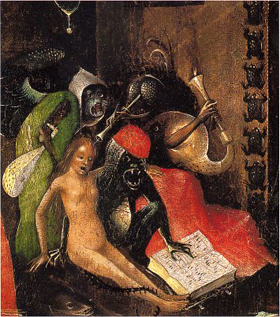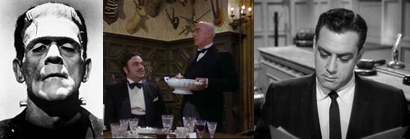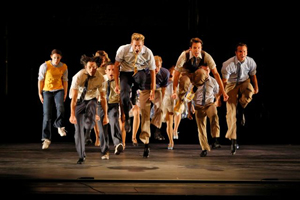
Diabolus in Musica
Musty medieval theorists coined the title of today's article, in reference to an insignificant little something, just two notes and the space between. Hardly worth invoking the devil over such a trifle.

All this over a few measly notes
They were plainly bugged by the thing, nonetheless. The interval in question corresponds to three whole steps in distance -- play from C-natural to F-sharp on the piano. It is called the tritone, etymology I think clear enough. We use the term "tritone" when we don't actually know how the interval is notated; it can be written either as an augmented fourth (C-F-sharp) or a diminished fifth (C-G-flat). "Tritone" also makes a handy generic term for the sonority, shorter and easier on the ears than the more precise labels.
At first blush one would assume those symbol-obsessed medievalists would fall on the tritone with glad little cries of joy. It divides the octave perfectly: from the lower C to F# is a tritone; from F# to the C above is also a tritone. It sits right smack dab there in the middle; flip a tritone upside down, and you get another tritone.
But the tritone is a sharply dissonant sonority hovering right between two "perfect" intervals -- the fourth and the fifth, intervals comprised of notes acoustically very near each other. Because of that, fourths and fifths are easy to sing (and mix up), whereas tritones that appear out of the blue in a musical texture may well be inadvertently Bowdlerized into fourths or fifths, depending on the overall thrust of the phrase.
So there was a certain practical aspect to the theorists' fastidious dismay. Tritones caused intonation problems (i.e., the singers went out of tune) and therefore were prohibited in quality writing. (The same problem lies partly behind the age-old prohibition against augmented seconds; they're also an intonational train wreck just waiting to happen.)
But more than anything else I think it was the sharpness of the dissonance that gave the theorists goose pimples. In all likelihood, tritones were heard fairly often in early polyphony, as it developed from the time of Charlemagne onwards until flowering into a relatively exact art with the composers of the "Notre Dame School" of the 12th century. When the theorists started writing books they started prohibiting what they didn't like; by extension we may therefore assume that the practices that elicited their harshest condemnation weren't particularly obscure, otherwise theorists wouldn't have gotten their knickers so thoroughly into knots.
Nevertheless tritones lived on despite the best efforts of tonsured church musicians to wipe them out. They managed to become downright essential to traditional eighteenth century harmony -- in fact, it's the tritone and its resolution (to either a third or a sixth, depending on the spelling) that Aldwell & Schachter refer to as "the key-defining progression" in their college-standard text "Harmony and Voice Leading." Classical harmony would water itself down to mush without tritones.
But tritones continue to emit a sinister aura. The lurching Frankenstein monster threatens a chesty dirndl-clad starlet: tritone. The butler steps forward and reveals that it was actually Sir Nigel FitzPughley who did it in the drawing room with the candlestick: tritone. Perry Mason grills a witness remorselessly until that blowzy slattern in the back of the courtroom leaps up shrieking Yes Yes YES I Killed Him And I'm Glad I'm Glad I'm Glad Do You Hear Me BLEARRRRGHHH!!!: tritone.

The tritone: one interval to rule them all
And yet tritones aren't necessarily limited to kitsch. They have their noble uses as well.
Consider Billy Bigelow's soliloquy on his impending fatherhood, in Rodgers & Hammerstein's Carousel:
I wonder what he'll think of me,
I guess he'll call me "the old man"...
When Billy gets to "the old man", he sings an abrupt upwards leap, landing on an upper tritone on "man." Billy's insecurity and wonder are heightened by that superb bit of word painting.
Bernstein's West Side Story is a gold mine for tritone hunters. The very opening of the score -- those three notes G-C...........F#! -- outline a slashing tritone from second to third notes. The sound is a bit ominous, to be sure, but also energetic.
That tritone continues to thread through the score, really acting as a leitmotiv, shifting its mood with the characters. Tony falls in love and sings Maria: from 'Ma' to 'ri' is a tritone, and the name altogether is C-F#-G, i.e., a variation on that opening motive.
The Jets prepare for their forthcoming rumble with the Sharks; they're nervous and so Biff sings Cool: C-F#; G-C. Again a variant on that opening motive, this time filled with restless energy and sexual tension.

Photo © by Richard Termine
It's worth noting, perhaps as an aside, that the rival Sharks (and their women) avoid the tritone for the most part, although not across the board. (Harmony, remember.) Their signature interval appears to be the fourth--consider America, which outlines the fourth ("I like to be in A-mer-i-ca" outlines a fourth until the second syllable of "America"), or I Feel Pretty ("I feel pret-" outlines a perfect fourth), or A Boy Like That ("A boy like that, who killed your brother" -- "your brother" starts with a fourth.)
Moving into the symphonic realm, any music written in the whole-tone scale (such as works by Debussy) is likely to make extensive use of tritones, and they won't be dissonant, either. The tritone is such a strong part of the whole tone scale that the interval loses most of its fangs and becomes a near-consonance. The same is true of the octatonic mode, such as you might find in Debussy's Feuilles mortes, works by Bartók, or even in a lot of modern jazz. The tritone is persistent and non-dissonant.
Sibelius made glorious use of the tritone in his Fourth Symphony as a means of emotional color, using the interval's connotation of menace to its fullest, but never treating it as a classical harmonic dissonance requiring resolution.
So here's to the lowly tritone, condemned as "the devil in music" by the superstitious Middle Ages, given an important role in the scheme of things by the Enlightenment, and nowadays serving in a multitude of roles ranging from goth-shock to liquidescent luminosity.
Not bad for a measly couple of notes.
Herr Doktor Professor Foglesong suggests the following for supplemental listening:
- The original scores for those grand old Universal horror classics have been lovingly restored and recorded. Try House of Frankenstein, on Marco Polo/Naxos, a late "monster mash" that deftly assembles every cliché in the book.
- Carousel has been recorded repeatedly since the original cast album first appeared on Decca. I particularly like the Sir Cameron Mackintosh revival, which makes up for in theatrical passion what it lacks in vocal splendor -- and with Audra McDonald singing Carrie Pipperidge, it isn't exactly bupkis in the vocal splendor department, either.
- You can hear West Side Story best via the original cast album, expertly remastered and widely available from Sony/BMG. Avoid Bernstein's late outing with opera stars; it does a great American score a disservice.
- Debussy's use of tritones can be experienced in the Preludes for piano; Feuilles mortes comes from the second volume. Many pianists have recorded them; I am particularly fond of Pascal Rogé's warm, personal approach.
- The Sibelius Fourth has been recorded numerous times. I recommend Herbert Blomstedt and the San Francisco Symphony, on Decca, Osmo Vanska conducting the Lahti Symphony Orchestra on BIS, and any of Herbert von Karajan's traversals with the Berlin Philharmonic, one on DG, and the other on EMI.
